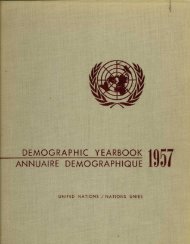Manual on Statistics of International Trade in Services
Manual on Statistics of International Trade in Services
Manual on Statistics of International Trade in Services
You also want an ePaper? Increase the reach of your titles
YUMPU automatically turns print PDFs into web optimized ePapers that Google loves.
4. Statistical treatment <strong>of</strong> modes <strong>of</strong> supply: the<br />
simplified approach<br />
2.72. Modes <strong>of</strong> supply are central to GATS. They are<br />
def<strong>in</strong>ed <strong>in</strong> its very first article and are the basis <strong>on</strong> which<br />
WTO member countries’ commitments are scheduled.<br />
The <str<strong>on</strong>g>Manual</str<strong>on</strong>g> <strong>in</strong>troduces, for the first time, modes <strong>of</strong><br />
supply <strong>in</strong> the statistical c<strong>on</strong>text.<br />
2.73. However, a comprehensive statistical treatment<br />
<strong>of</strong> modes <strong>of</strong> supply that would fully mirror the GATS<br />
legal def<strong>in</strong>iti<strong>on</strong> and other GATS articles would be out <strong>of</strong><br />
the scope <strong>of</strong> the present <str<strong>on</strong>g>Manual</str<strong>on</strong>g>. Such an approach<br />
would fail to ensure compatibility with <strong>in</strong>ternati<strong>on</strong>al<br />
statistical systems, such as BPM5 and the 1993 SNA,<br />
and would demand excessive resources for<br />
implementati<strong>on</strong>.<br />
2.74. Draw<strong>in</strong>g <strong>on</strong> GATS legal provisi<strong>on</strong>s, the <str<strong>on</strong>g>Manual</str<strong>on</strong>g><br />
proposes, as a first approximati<strong>on</strong>, a simplified approach<br />
to the statistical allocati<strong>on</strong> <strong>of</strong> trade <strong>in</strong> services to modes<br />
<strong>of</strong> supply that is operati<strong>on</strong>al <strong>in</strong> the statistical c<strong>on</strong>text and<br />
c<strong>on</strong>sistent with <strong>in</strong>ternati<strong>on</strong>al statistical standards.<br />
(a) Simplified statistical criteria<br />
2.75. To allow the allocati<strong>on</strong> <strong>of</strong> services transacti<strong>on</strong>s to<br />
modes <strong>of</strong> supply <strong>in</strong> a systematic way, the <str<strong>on</strong>g>Manual</str<strong>on</strong>g><br />
proposes unambiguous criteria derived from the GATS<br />
def<strong>in</strong>iti<strong>on</strong>s. The <str<strong>on</strong>g>Manual</str<strong>on</strong>g> acknowledges that this<br />
allocati<strong>on</strong> is <strong>on</strong>ly a first step <strong>in</strong> the estimati<strong>on</strong> process<br />
and that further research and empirical <strong>in</strong>formati<strong>on</strong> will<br />
be required both to validate and to ref<strong>in</strong>e the estimates.<br />
These simplified criteria are based <strong>on</strong> the follow<strong>in</strong>g<br />
c<strong>on</strong>siderati<strong>on</strong>s:<br />
(a) To the extent that foreign affiliates are a good<br />
approximati<strong>on</strong> <strong>of</strong> commercial presence entities, FATS<br />
statistics provide <strong>in</strong>formati<strong>on</strong> <strong>of</strong> service supplied<br />
through mode 3;<br />
(b) Service transacti<strong>on</strong>s between residents and n<strong>on</strong>residents,<br />
as captured <strong>in</strong> the balance <strong>of</strong> payments<br />
accounts described <strong>in</strong> the BPM5 system, broadly cover<br />
mode 1, mode 2, and part <strong>of</strong> mode 4. 37<br />
37 There are some limitati<strong>on</strong>s, however, to the assimilati<strong>on</strong> <strong>of</strong><br />
commercial presence entities to foreign affiliates or to the<br />
corresp<strong>on</strong>dence between BPM5 service transacti<strong>on</strong>s and<br />
modes 1, 2 and 4. For example, such limitati<strong>on</strong>s relate to the<br />
foreign ownership criteria used for the identificati<strong>on</strong> <strong>of</strong><br />
foreign affiliates and to the residence criteria that underp<strong>in</strong><br />
statistical systems, while GATS legal provisi<strong>on</strong>s are not based<br />
20<br />
2.76. It is therefore possible to derive much<br />
<strong>in</strong>formati<strong>on</strong> <strong>on</strong> services transacti<strong>on</strong>s by modes <strong>of</strong> supply<br />
from BPM5 and FATS statistics. However, the fourth<br />
mode <strong>of</strong> supply, mode 4, goes bey<strong>on</strong>d the noti<strong>on</strong> <strong>of</strong><br />
“services transacti<strong>on</strong>s” <strong>in</strong> BPM5 and FATS. It would be<br />
necessary to draw <strong>on</strong> supplementary data from BPM5<br />
and FATS as well as from other statistical systems, such<br />
as migrati<strong>on</strong> and labour market statistics, to have a<br />
broader picture <strong>of</strong> mode 4.<br />
2.77. The simplified statistical criteria are based <strong>on</strong> the<br />
territorial locati<strong>on</strong> <strong>of</strong> the transactors (c<strong>on</strong>sumer and<br />
supplier) at the time the service is supplied, as well as <strong>on</strong><br />
the type <strong>of</strong> the supplier (an <strong>in</strong>dividual or a bus<strong>in</strong>ess<br />
enterprise, respectively termed “natural or juridical<br />
pers<strong>on</strong>s” <strong>in</strong> GATS). They yield the same results as the<br />
GATS def<strong>in</strong>iti<strong>on</strong> <strong>in</strong> most cases, while also provid<strong>in</strong>g<br />
clear guidel<strong>in</strong>es for those that present special difficulties.<br />
However, it should be stressed that the <str<strong>on</strong>g>Manual</str<strong>on</strong>g>’s<br />
guidel<strong>in</strong>es <strong>on</strong> the compilati<strong>on</strong> <strong>of</strong> statistics by modes <strong>of</strong><br />
supply are laid out <strong>on</strong>ly for statistical purposes and do<br />
not imply any legal <strong>in</strong>terpretati<strong>on</strong> <strong>of</strong> GATS provisi<strong>on</strong>s.<br />
These criteria are shown <strong>in</strong> chart 1. In additi<strong>on</strong>, each<br />
mode <strong>of</strong> supply is further illustrated <strong>in</strong> chart 2.<br />
2.78. These statistical criteria for the allocati<strong>on</strong> <strong>of</strong><br />
modes <strong>of</strong> supply are further complemented with<br />
simplificati<strong>on</strong> rules discussed below.<br />
(b) Balance <strong>of</strong> payments statistics by modes <strong>of</strong> supply<br />
2.79. Balance <strong>of</strong> payments service transacti<strong>on</strong>s broadly<br />
corresp<strong>on</strong>d to mode 1, mode 2, and part <strong>of</strong> mode 4. Yet a<br />
given balance <strong>of</strong> payments service category generally<br />
<strong>in</strong>cludes transacti<strong>on</strong>s corresp<strong>on</strong>d<strong>in</strong>g to several modes.<br />
Moreover, several modes <strong>of</strong> supply may be used for a<br />
s<strong>in</strong>gle service transacti<strong>on</strong>. With a view to facilitat<strong>in</strong>g the<br />
analysis and compilati<strong>on</strong> <strong>of</strong> service transacti<strong>on</strong>s between<br />
residents and n<strong>on</strong>-residents by modes <strong>of</strong> supply, the<br />
<str<strong>on</strong>g>Manual</str<strong>on</strong>g> suggests the use <strong>of</strong> two simplificati<strong>on</strong> rules.<br />
2.80. First, separate identificati<strong>on</strong> <strong>of</strong> modes deemed to<br />
be relatively marg<strong>in</strong>al <strong>in</strong> a given service category is not<br />
recommended. Thus, if the major part <strong>of</strong> a given service<br />
category corresp<strong>on</strong>ds to services supplied under <strong>on</strong>e<br />
mode, this mode could be fully allocated to that service<br />
category. For example, telecommunicati<strong>on</strong>s services<br />
would be allocated to cross-border supply (mode 1)<br />
because most transacti<strong>on</strong>s between residents and n<strong>on</strong>-<br />
<strong>on</strong> these statistical criteria. These limitati<strong>on</strong>s are discussed<br />
further <strong>in</strong> the present chapter as well as <strong>in</strong> chapters III and IV<br />
below.

















